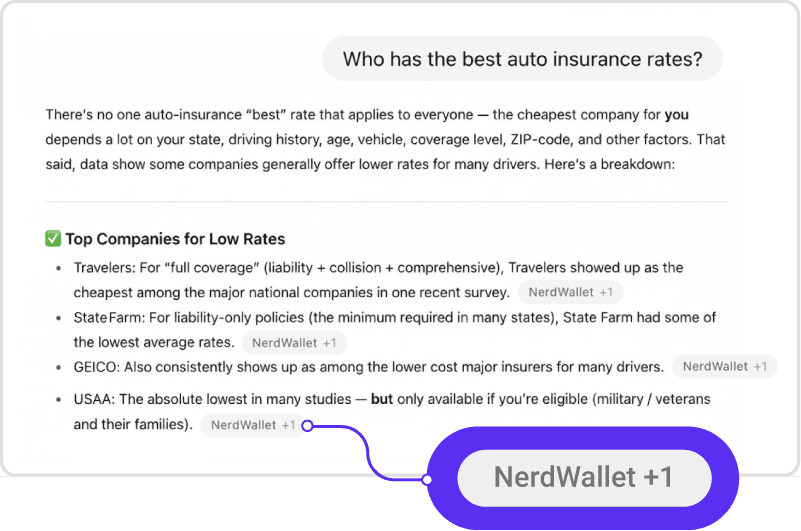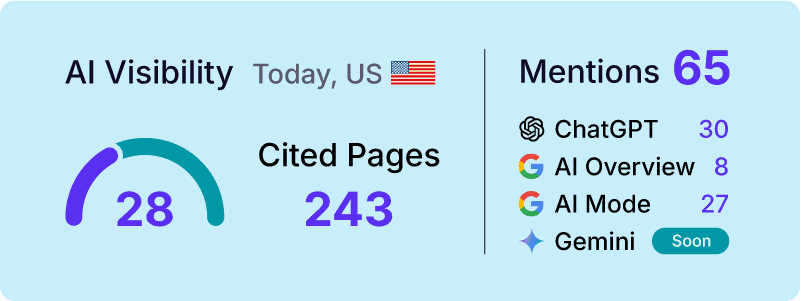Google launched its experimental “Search Generative Experience” in May 2023 before officially launching AI Overviews one year later. Since then, AI Overviews have become a standard search experience on the world’s leading search engine. Although AI engines only account for less than 2% of the total search market, increasing numbers of users are exploring AI organic search, a trend which we expect to continue.
As search engine optimization evolves in answer engine optimization (AEO), marketers should consider how to position their brand so AI-driven engines can understand and present their assets as authoritative, informative answers to increasingly complex searches.
1. Evolution of Search
According to a Pew Research Study, AI Overviews were present in 58% of searches in March of 2025. Furthermore, 34% of US adults had used ChatGPT as of June 2025 — roughly twice as many as in the summer of 2023. While global usage is still heavily tilted toward traditional search engines like Google and Bing, AI-powered search is growing at eyebrow-raising rates; ChatGPT’s market share increased nearly fourfold from 2024 to 2025, and Perplexity doubled its market share over the same time period.
As users grow more familiar and comfortable with AI, all indicators point toward increased reliance on AI-assisted search. Search engine optimization efforts must evolve to tackle this new frontier. Regardless of what you call it — answer engine optimization, generative engine optimization (GEO), large language model optimization (LLMO) — search marketers and brands must adapt, particularly if they want to attract the attention of younger users. Over half of ChatGPT users are between 18 and 34 years old.
Search results are now often displayed as summarized responses to user questions. On Google, these responses can dominate above-the-fold real estate. In many cases, the answers are so complete that the user never clicks a link or visits the website. These “zero clicks” are having a negative impact on traditional metrics like organic visits and CTR, as the user can find all the information they need within the search result. As a result, marketers must adapt how they measure success and re-evaluate how users search.
2. From Keywords to Questions
Traditional search engines functioned by providing a list of links to users entering relatively simple search terms — keywords. This enabled SEO efforts to rely on keyword data and search result performance to optimize websites for targeted phrases that matched user intent with a brand’s product or services, with additional focus placed on technical website performance.
AI-powered search, on the other hand, allows users to enter complex prompts while expecting a long-form, conversational answer. Instead of pulling data exclusively from a brand’s website and associated links to provide an answer, AI engines scan their entire database to form an answer. This means that user reviews, forum discussions, product reviews, social media content, and other material outside of a brand’s control influence the answer an AI engine uses in response to a prompt.
Keyword optimization is no longer enough. Answer engine optimization requires brands to consider how they can position themselves as authorities within their space to drive AI-driven search visibility, while ensuring conversations about their services and products accurately reflect the brand. At the same time, they must ensure their websites are accessible to LLMs, their crawlers, and the traditional search indexes that power many of today’s AI organic search engines.
3. Measuring Success
In SEO, success was measured by tracking keyword rankings, organic impressions, and organic clicks. While there will continue to be a place for traditional search to respond to the millions of simple searches that occur every day, it can no longer be a brand’s sole organic focus. AEO success will be measured by references in AI responses (AI citations) and by being able to measure the sentiment of that response.

Does the AI paint your brand in a positive light, or call out themes from negative reviews? If a customer is cross–shopping your brand against competitors, which brand does the AI recommend? Do AI engines reference your brand when customers are exploring your vertical?

As of this writing in Q4 of 2025, there is no definitive set of success metrics for AEO efforts. The search industry is rapidly adjusting to AI, and search analytics providers are racing to enhance toolsets for marketers and agencies. Partner with trusted consultants and agencies to track this space as it matures.
4. Take Action
Fortunately, marketers can adapt strategies quickly to meet the demands of AI engine optimization. Ensuring websites have high-quality, authoritative content that addresses a range of user questions will enhance AI results about your brand. Consider FAQ and conversational-like content. Optimize structured data, schema markup, site speed, and accessibility for crawlers (such as reducing JavaScript) to make it easy for engines to access your refreshed content.
Brands should also consider “earned” media — that is, brand mentions and conversations from third-party sources. This includes review management, social media campaigns, and other community management efforts to bolster brand image and sentiment across all mediums AI pulls from.
For brands with regional or national retail networks, providing co-op-eligible social media, reputation, and local listings management programs can incentivize local rooftops to take control of these conversations, influence customer sentiment, and shift overall brand perception — which will directly influence AI responses. For local rooftops, ask your regional brand representative about partnering with Ansira for earned media solutions to put your best foot forward in an AI-search world.
Companies that pivot to AEO early will hold an advantage against brands that don’t. They will be more discoverable in AI-powered organic search and will appear more trustworthy and authoritative as a result. In addition, they’ll be better positioned to adapt to further changes in the search space as AI-driven engines and consumer behavior continue to evolve.
